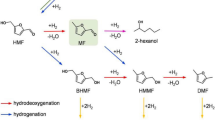Abstract
Reaction pathways for 14C labeled acetic acid (at both carboxylic and methyl positions) added during Fischer-Tropsch synthesis over a doubly promoted fused iron catalysts were studied in a CSTR at 100 psig, 270 °C and ca. 90% CO conversion. The addition of acetic acid slightly affected the CO conversion but results in a significant reduction in H2 conversion. Both the unlabeled and labeled acetic acid addition caused a large decrease in the alkene ratio for C2 hydrocarbons as compared to an increase for the C3 and C4 hydrocarbons suggesting a direct formation pathway of ethane from added acetic acid. The 1-alkene/2-alkene fraction was found to increase significantly when acetic acid was added and returned to the original value once the addition is terminated, indicating inhibition of hydrogenation activity of the catalyst by acetic acid. Distribution of 14C suggests some C–C bond rupture and direct formation of ethane from labeled acetic acid. In the case of 1-14C labeled acetic acid addition, the gradual increase of the relative molar activity (14C content per mole) with carbon number reveals that 14C containing part of acetic acid initiate chain growth and also participates in the chain propagation for hydrocarbon formation in FTS. When acetic acid labeled at methyl position was added, the results indicated that 14C containing part of acetic acid participates in chain initiation only. The addition of acetic acid decreases methane and methanol selectivity while it increases ethanol, acetaldehyde and acetone selectivity in FTS. Reaction of acetic acid during FTS was found to produce products like ethyl butanoate, ethylene glycol, and its ether, 1,2-diethoxyethane which are not generally observed in the normal FTS product spectrum. The results indicate that acetic acid is not a significant intermediate in FTS with an iron catalyst. 14C-distribution in most of the labeled oxygenate compounds are consistent with the hydrogenation of the acetic acid to acetaldehyde and/or ethanol as primary products followed by secondary reaction of these two primary oxygenate products.












Similar content being viewed by others
References
Roelen O (1943) U. S. Patent 2327066
Wender I (1996) Fuel Process Technol 48:189
Biloen P, Sachtler WMH (1981) Adv Catal 30:165
Bell AT (1981) Catal Rev Sci Eng 23(2):203
van der Lee G, Ponec V (1987) Catal Rev Sci Eng 29(2–3):183
Tau L-M, Dabbagh HA, Davis BH (1991) Energy Fuels 5:174
Kummer JT, Emmett PH (1953) J Am Chem Soc 75:5177
Weitkamp AW, Frey CG (1953) J Ind Eng Chem 45:363
Chen W, Ding Y, Jiang D, Wang T, Luo H (2006) Catal Commun 7:559
Xu B, Sun K, Zhu Q, Sachtler M (2000) Catal Today 63:453
Hanlon RT, Satterfield CN (1988) Energy Fuels 2:196
Tau L-M, Robinson R, Ross RD, Davis BH (1987) J Catal 105:335
Kummer JT, Podgurski HH, Spencer WB, Emmett PH (1951) J Am Chem Soc 73:564
Raje A, Davis BH (1995) Catalysis 12:53
Tau L-M, Dabbagh HA, Davis BH (1990) Energy Fuels 4:94
Pichler H, Schulz H (1970) Chem Ing Tech 42:1162
Johnston O, Joyner RW (1993) In: Guczi L, Solymosi F, Tétényi P (eds) New Frontiers in Catalysis, Proceedings of the 10th International Congress on Catalysis—Part A, Studies in Surface Science and Catalysis, vol 75. Elsevier Science, Amsterdam, p 165
Blyholder G, Shihabi D (1977) In: Bond GC, Wells PB, Tompkins FG (eds) Proceedings of the 6th International Congress on Catalysis, vol 1. The Chemical Society, Letchworth, England, p 440
Hall WK, Kokes RJ, Emmett PH (1957) J Am Chem Soc 79:2983
Author information
Authors and Affiliations
Corresponding author
Rights and permissions
About this article
Cite this article
Sarkar, A., Keogh, R.A., Bao, S. et al. Fischer-Tropsch Synthesis: Reaction Pathways for 14C-Labeled Acetic Acid. Catal Lett 120, 25–33 (2008). https://doi.org/10.1007/s10562-007-9261-z
Received:
Accepted:
Published:
Issue Date:
DOI: https://doi.org/10.1007/s10562-007-9261-z




